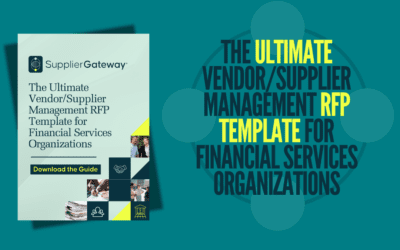It’s not easy being in charge of finding and securing the best possible suppliers for your business. It’s even harder to maintain healthy, productive supplier relationships. But it’s a critical component of success, and one that can be mastered with a little know-how.
In this short guide to supplier relationship management, we’ll teach you the basics on how to get started. You’ll learn how to organize your current supplier data, capture accurate data going forward, monitor and optimize your supplier relationships, and maintain positive relationships with your suppliers long-term.
What Is Supplier Relationship Management?
Supplier Relationship Management, or SRM, is a process that helps buyers maintain good relationships with their suppliers. SRM affects the entire supplier lifecycle—from finding new suppliers and maintaining good communication with them to ensuring that suppliers meet their contractual obligations. It also ensures that you as a buyer hold up your end of the contract as well.
SRM implementation can be overwhelming, but it’s worth the effort. Your suppliers are an essential part of your business. Keeping track of your suppliers, identifying areas of supplier improvement, and ensuring that your suppliers are always meeting your expectations are all benefits to starting a supplier relationship management program.
The Benefits of Supplier Relationship Management
Implementing a supplier relationship management program improves communication, shortens order lead times, reduces stockouts, and improves overall supplier performance. What this means for your business is time and cost savings, reduced time to market, and positive impact on your overall bottom line.
SRM benefits suppliers as well. For suppliers, SRM can mean better communication, improved performance metrics, faster payment, and increased chances of winning future contracts.
Implementing SRM can be a challenge, but the benefits are clear. With the right tools and procedures in place, your company can achieve better relationships with suppliers, see improved performance across the board, save time, and reduce cost.
Supplier Data Management & Optimization
Let’s face it. Chances are, your supplier data is a disorganized mess that no one wants to deal with. However, your supplier data is the keystone to running a successful supplier relationship management program. When it comes to supplier master data management, your goal should be to cleanse, organize and optimize your supplier data. This will help you make better decisions about who to do business with, and who to partner with.
There are a few ways to go about this:
- Review your suppliers and remove any that are no longer relevant
- Clean up your supplier data by consolidating duplicates and removing incorrect information
- Organize your data by supplier category, geography or product category
- Use optimization tools to identify the best suppliers for your business
By taking the time to clean up and optimize your supplier data, you’ll be able to make more informed decisions about which suppliers to work with, and ultimately improve the efficiency and effectiveness of your entire supply chain.
Supplier Onboarding & Supplier Monitoring
Your supplier onboarding and monitoring processes should cover all aspects of the supplier lifecycle—from initial selection and negotiation to ongoing communication and review.
It’s important to have a structured supplier onboarding process that efficiently collects the right supplier data. This first step in supplier management is crucial to the overall supplier relationship management process. If your onboarding includes the following, you’ll have fewer headaches to deal with in the future:
- Centralized data collection. All supplier data should be housed in a centralized database. This prevents the need to update multiple entries in different databases for the same suppliers and reduces data siloing.
- Self-service. Suppliers should be able to onboard themselves at their convenience via an online portal. This means all supplier data is collected up front, from one single source of truth—the supplier themselves.
- Supplier profile self-management. Suppliers should be able to access and manage their own profile within your supplier management system. That way, suppliers can make information updates as needed to keep their profiles current and accurate.
- Automated alerts. Automated alerts send notifications to suppliers whenever a document in their profile needs to be updated or is about to expire. This saves you from having to chase down paperwork from hundreds or thousands of suppliers.
You’ll also want to develop a framework that outlines how suppliers will be monitored and evaluated on an ongoing basis. This can include performance reviews, audits, or other methods for measuring quality. Any framework for review or evaluation needs to be stated contractually, so that both you and your supplier are on the same page.
These review requirements should also include performance indicators for your company as well. For instance, on-time payments over a period of time could grant your company better payment options, such as net 60 instead of net 30.
The goal here is to ensure that the supplier is providing you with quality products or services, and is meeting any contractual requirements. This type of relationship management can help ensure consistency over time and lead to better customer satisfaction.
Supplier Relationship Management Software
Looking for a way to streamline your supplier relationships? Supplier relationship management (SRM) software can help. It helps you keep track of suppliers, manage contracts, and make sure you are getting the best value for your money.
SRM software can help you simplify processes like source-to-pay, procurement, supplier onboarding, and supplier risk management. It can also provide data that can be used to analyze supplier performance over time. This level of automation makes it much easier to monitor supply chains and measure performance metrics—like delivery times and quality of goods—that are critical to your bottom line.
In addition to providing visibility into the supplier network and enabling better decision-making, SRM software also helps with communications—allowing users to quickly message specific suppliers or groups with important updates or notices. Finally, the software allows for automated tracking and reporting on KPIs related to supplier performance.
Best Practices for Successful Supplier Relationship Management
Having a successful supplier relationship management strategy can help ensure that your business operates efficiently and cost-effectively. Here are some of the best practices to ensure that you’re on the right track:
Establish clear, documented expectations. Make sure that expectations are understood by both parties. Establishing these expectations up front will help to avoid any potential misunderstandings down the road.
Develop an open line of communication. Developing a strong line of communication between yourself and your supplier can help ensure that all needs are being accounted for. Encourage healthy conversations and ensure that supplier feedback is taken into consideration in order to foster an effective working relationship.
Foster relationships based on trust. Building trust between you and your suppliers is essential for successful relationships. Provide clear communication about what you expect from the supplier and make sure that deadlines are met accordingly by all parties. This will help build mutual trust, which is essential for successful partnerships.
Conclusion
Supplier relationship management is vital to the success of your business. By having a central place to manage your supplier relationships, you can streamline your processes, improve communication, and make sure that you’re getting the best possible service from your suppliers.
With the right supplier relationship management software in place, you can automate many of the tasks associated with supplier management, making it easier to keep track of your supplier relationships and ensuring that you’re getting the most out of your partnerships.
Ready to talk with our experts about our supplier management solutions? Request a demo and start taking control of your supply chain.











